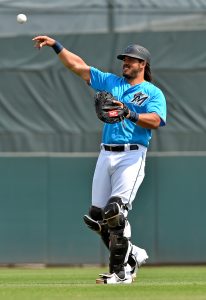The pitching arms race is in a fascinating place. There’s velocity everywhere you look. Pitch development and analysis has grown by leaps and bounds. Physical tools interact with tunneling and sequencing/location strategies. It’s an ever-changing landscape, leaving ample room for players to emerge — particularly in the relief realm, where a hurler may only be a tweak or two away from emerging as a dominant force. (The opposite also holds true.)
Let’s take a look around the league at some relief pitchers who have debuted or exhibited intriguing new performance levels in 2019 and consider which seem most likely to continue:
Nick Anderson, Marlins: When you’re a relief pitcher with a rebuilding club who turns 29 in the summer of your debut season, expectations just aren’t going to be all that high. A seemingly minor pre-Rule 5 trade acquisition, Anderson has taken off in Miami with 11 innings of 2.45 ERA pitching and a whopping 22 strikeouts on an 18.4% swinging-strike rate. He has only handed out two free passes, both of them intentional walks. The Twins would surely like a re-do on the decision to part with Anderson. (Their own late-blooming relief success story, Ryne Harper, doesn’t have nearly the shiny peripherals to support his useful showing thus far.)
Robert Stephenson, Reds: It was do-or-die time for the 26-year-old former top prospect, who’s out of options. He’s doing quite nicely thus far, with a 2.08 ERA and 12.5 K/9 against 2.8 BB/9 over 13 innings of action. While the talent has never been in question, the results have never really been there for Stephenson. But he’s thriving in a pen role and showing that the stuff plays legitimately against MLB hitters, with a 19.4% swinging-strike rate. He’s leaning heavily on his slider (59.3%), mixing that primarily with a 94.9 mph fastball. It seems the tools are there for continued success.
Sam Gaviglio, Blue Jays: Sometimes, moving from the rotation to the pen results in a boost, and that seems to be the case here. All the arrows are pointing up for the righty as he closes in on his 29th birthday: K%-BB% (25.9%); swinging-strike rate (16.9%); groundball rate (54.3%). He still doesn’t throw hard, but he’s closer to 90 mph on average than ever before with his sinker. And in a relief capacity, Gaviglio has been able to go much more frequently to his slider (44.6%). With a 1.20 ERA in 15 innings, the results have followed.
Brandon Brennan, Mariners: 9.6 K/9 vs. 2.4 BB/9 and a 58.3% grounder rate? That’ll work. It’s a 15-inning sample, but an impressive one for a player who was plucked in the Rule 5 draft after signing a minor-league deal with another club. He’s carrying a hefty 16.3% swinging-strike rate while punishing opposing hitters with equal doses of a mid-nineties heater and evidently improved change. Seattle may well have a keeper in the 27-year-old righty.
Trevor Gott, Giants: After failing to turn the corner for several seasons with the Nats, Gott has finally seemed to get it in San Francisco. Through 13 innings he owns a 2.08 ERA with 9.7 K/9 and 2.1 BB/9. Gone are the grounders that were once his greatest attribute; also missing so far are the homers that plagued him. Gott is now working primarily off of a four-seamer instead of a two-seamer, allowing him to nearly triple his swinging-strike rate from last year (5.6% to 14.2%).
Luke Jackson, Braves: Though he threw 91 1/3 innings with Atlanta over the prior two seasons, Jackson was bounced from the 40-man roster on several occasions and was never secure in a role. He may be on to something in 2019, though. He’s still handing out too many walks, but Jackson has also bumped his swing-and-miss capabilities (11.9 K/9, 15.0% SwStr%) by boosting his slider usage (52.2%) and drawing more chases out of the zone (41.1%). Most fascinating of all? Through 11 1/3 innings, Jackson is a groundball monster, with 21 of the 28 balls put in play against him classed as grounders. Average opponent launch angle? A smooth -5.6 degrees.
Connor Sadzeck, Mariners: While he got results in a brief stint last year with the Rangers, there were glaring walk issues. Sadzeck has righted the ship so far with his new organization, allowing one earned in eight frames with nine strikeouts and three walks. He’s going to his slider more than half the time and generating a solid 13.6% swinging-strike rate thus far. Most importantly, getting strikes on 60.0% of his first pitches has set Sadzeck up to continue limiting the free passes.
Nick Wittgren, Indians: In the bullpen game, you win some, you lose some. Miami parted with Wittgren after the 27-year-old turned in a solid but hardly overwhelming 2018 season. He seems to have found another gear in Cleveland, though it remains to be seen whether it’s sustainable. Wittgren has eleven strikeouts without a walk through eight innings and is carrying a 58.8% groundball rate — markers of dominance he has never previously hinted at. He’s throwing much the same pitches at much the same speeds and generating only an 8.4% swinging-strike rate, so it seems there may be some short-sample hijinks at play.
Ian Kennedy, Royals: The 34-year-old is a veritable rookie as a reliever, having spent the virtual entirety of his pro career to this point in a rotation. He’s finding new life as a pen piece, working to a 1.42 ERA with 12.1 K/9 and 1.4 BB/9 along with a 48.5% groundball rate over 12 2/3 frames. He hasn’t found new heights in the swing-and-miss department (10.3% is at, but not over, his career ceiling as a starter) but is working with newfound velocity (94.2 mph average four-seamer) and seems to have benefited from shelving his change in favor of his curve.
Jake Newberry, Royals: A much younger K.C. entrant takes the final spot (which could also have gone to newcomer Richard Lovelady or a few other contenders). Another hurler who is finding success with heavy slider usage, Newberry has boosted his swinging-strike rate from under ten percent last year to 15.8% in 2019. He’s rarely in the zone (31.5%) but has a 10:1 K/BB ratio over eight innings since he is getting first strikes three out of five times and having no problem convincing opposing batters to chase out of the zone (36.8%). The 24-year-old is inducing loads of fly balls, which could spell trouble if they begin to leave the yard. It’s a delicate balancing act that’ll be tough to sustain.
Honorable mention (or: “what about [player x]?!”):
Guys like Matt Barnes, Reyes Moronta, and Lou Trivino have had too much success in the past to be considered, even if they are making further strides. Marcus Walden and Ty Buttrey were closer cases given their thinner track records, but largely showed their current form last season. Nick Burdi might have been considered despite his ugly ERA but for his unfortunate recent injury. Wander Suero, Giovanny Gallegos, Adam Morgan, Daniel Stumpf, Luis Cessa, Buck Farmer, and Kyle Ryan are among the pitchers who have shown quality swinging-strike rates or other intriguing developments. But they all had less innings and/or greater warts than the players listed above. I’d almost certainly have given a spot to John Means, but he’s not being utilized as a traditional short reliever.



